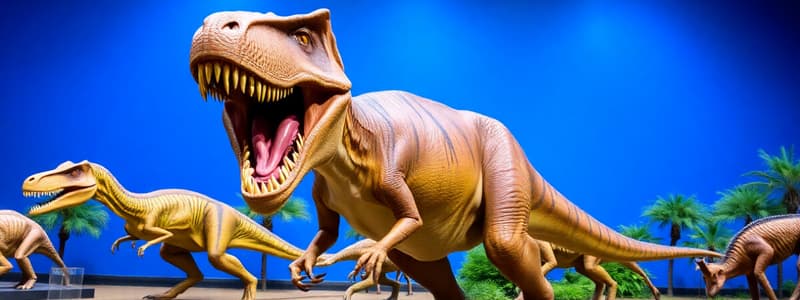Podcast
Questions and Answers
Where were Tyrannosaurus Rex primarily found during the Late Cretaceous Period?
Where were Tyrannosaurus Rex primarily found during the Late Cretaceous Period?
- Asia
- Western North America (correct)
- Antarctica
- Europe
What is the estimated speed that a Tyrannosaurus Rex could reach?
What is the estimated speed that a Tyrannosaurus Rex could reach?
- 35 miles per hour
- 45 miles per hour
- 25 miles per hour (correct)
- 15 miles per hour
How many serrated teeth did the Tyrannosaurus Rex have?
How many serrated teeth did the Tyrannosaurus Rex have?
- 60 (correct)
- 40
- 30
- 50
What is the weight range of a Tyrannosaurus Rex?
What is the weight range of a Tyrannosaurus Rex?
What type of animal was the Tyrannosaurus Rex classified as?
What type of animal was the Tyrannosaurus Rex classified as?
Which evolutionary group does the Tyrannosaurus Rex belong to?
Which evolutionary group does the Tyrannosaurus Rex belong to?
What is a possible hypothesis for the small arms of the Tyrannosaurus Rex?
What is a possible hypothesis for the small arms of the Tyrannosaurus Rex?
What significant feature was present in the head of the Tyrannosaurus Rex that helped with thermoregulation?
What significant feature was present in the head of the Tyrannosaurus Rex that helped with thermoregulation?
How does the brain size of a Tyrannosaurus Rex compare to other similar dinosaurs?
How does the brain size of a Tyrannosaurus Rex compare to other similar dinosaurs?
What is a characteristic of the jaws of the Tyrannosaurus Rex?
What is a characteristic of the jaws of the Tyrannosaurus Rex?
Flashcards
T-Rex: Apex Predator
T-Rex: Apex Predator
Tyrannosaurus Rex (T-Rex) was a dominant predator at the top of the food chain, meaning it had no natural predators.
T-Rex: Time and Place
T-Rex: Time and Place
The T-Rex lived in Western North America during the Late Cretaceous period, approximately 68 million years ago.
T-Rex: Size
T-Rex: Size
An average T-Rex measured around 40 feet long, comparable to the size of a school bus.
T-Rex: Weight
T-Rex: Weight
Signup and view all the flashcards
T-Rex: Speed
T-Rex: Speed
Signup and view all the flashcards
T-Rex: Brain Size
T-Rex: Brain Size
Signup and view all the flashcards
T-Rex: Brain Cooling
T-Rex: Brain Cooling
Signup and view all the flashcards
T-Rex: Teeth and Jaws
T-Rex: Teeth and Jaws
Signup and view all the flashcards
T-Rex: Diet
T-Rex: Diet
Signup and view all the flashcards
T-Rex: Small Arms
T-Rex: Small Arms
Signup and view all the flashcards
Study Notes
Tyrannosaurus Rex Overview
- The Tyrannosaurus Rex (T-Rex) was an apex predator, meaning it was at the top of the food chain with no natural predators.
- T-Rexs were primarily found in Western North America during the Late Cretaceous Period, approximately 68 million years ago.
- The average T-Rex measured around 40 feet long, comparable to a school bus.
- They weighed approximately 7 to 8 tons, also similar to the weight of a school bus.
- Despite its size, the T-Rex could reach speeds of up to 25 miles per hour.
Physical Characteristics and Adaptations
- T-Rex had an exceptionally large brain for its size, about twice that of similar dinosaurs like the Giganotosaurus.
- Its head had vents to help regulate brain temperature, similar to vents in modern alligators.
- T-Rex possessed 60 serrated teeth, each about a foot long, and jaws powerful enough to crush a car.
- T-Rex was a carnivore, preying on live animals and scavenging carcasses.
- Its strong sense of smell allowed it to detect prey, other predators, and potential mates. This sense of smell is comparable to modern house cats.
- T-Rex had unusually small arms for its body size, with two fingers on each hand.
- Despite their size, the arms were strong and equipped with four-inch claws.
Evolutionary Relationships and Controversies
- T-Rex is a member of the Ornithischia group of dinosaurs, which possess hip bones similar to modern birds.
- This places T-Rex as a distant relative to chickens.
- There is evidence suggesting that T-Rex may have had feathers.
- The purpose of its tiny arms remains debated amongst scientists. Hypotheses include:
- An evolutionary leftover.
- Assisting with non-predatory tasks such as gripping mates.
- Adaptation for slashing at short distances.
Summarizing Key Facts
- T-Rex was a formidable predator with a powerful bite, strong sense of smell, and a large brain.
- Its tiny arms are a subject of ongoing scientific inquiry.
- It is related to modern birds through the Ornithischia group.
Studying That Suits You
Use AI to generate personalized quizzes and flashcards to suit your learning preferences.
Description
Explore the fascinating world of the Tyrannosaurus Rex, one of the most famous dinosaurs. This quiz covers its physical characteristics, adaptations, and role as an apex predator during the Late Cretaceous Period. Test your knowledge about this incredible creature and its environment.




